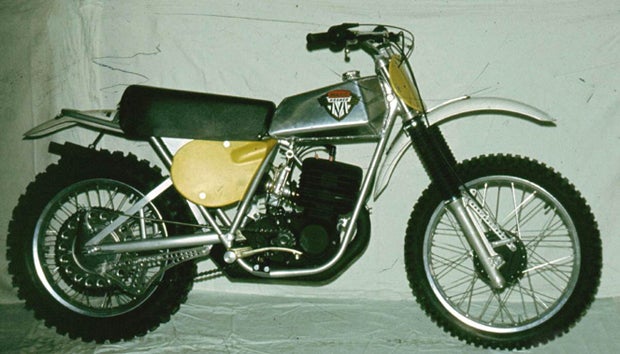
I returned from a vintage racing event in Boise, Idaho, and shortly thereafter received an email from one of the many great folks that I met. Let me share that email with you, and please note that it was the start of this feature on the incredibly rare Kramer Maico.
***
Hi Rick,
I am the guy that lent you my jacket in Boise! (It was cold there!) I failed to mention to you that I am in possession of a Kramer-Maico, and being a namesake, I had wanted one since I was 13.
My Dad told me of a cousin (Fritz) in Germany back then that used to build motorcycles, so it may be a close relative.
Anyways, I am getting ready to start this project and have read your column on the web and in Dirt Bike many years ago.
I am hoping to find out any information on these, when they were raced, etc. I am trying to convince the powers that be that they are vintage legal. Also, anything you can add about this is greatly appreciated.
Dave Kramer
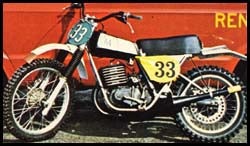
Editor's Note: The year was 1975 and suspension travel was just at the start of the long-travel revolution. In 1974, the longest travel any production bike had was about four inches. Yamaha came out with their monoshock design (a single shock under the saddle), and several other manufacturers started moving shocks forward and angling them all over the place.
A word about Vic Krause. Vic, at that time, owned a dealership in Chicago and was The Maico Man in the Midwest. He was also a good friend and even wrote the legendary Mister Know-It-All column for me in Modern Cycle and Dirt Bike.
So, sit back and enjoy the crusty writing style and learn some interesting facts about the bike that Maico never built … but certainly should have!
***
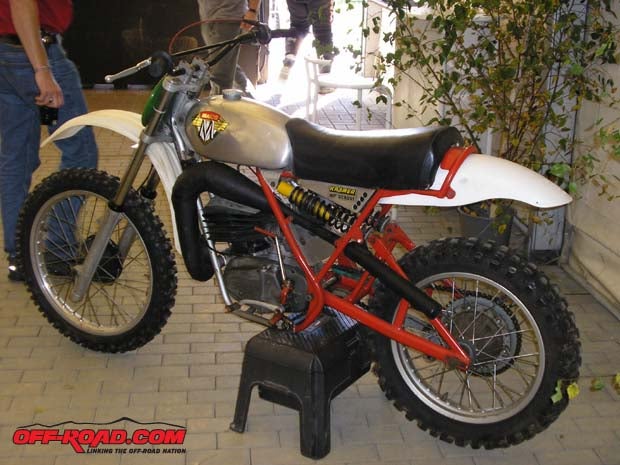
It was a dreary, uneventful winter afternoon on the outskirts of Chicago, as I sat in my shop pondering the meaning of nine straight days in mid-February without seeing the sun. It seemed as if Mother Nature had taken a two-week vacation and left Illinois to fend for itself.
I was desperately trying to find a convenient dealer tradeshow I could attend, but nothing was happening in either Jamaica or Acapulco.
Just when I thought the hinges on the showroom door might begin to rust closed, a van pulled into the parking lot, and into the showroom walked my first customer of the month. He was wearing an army jacket and some old fatigues. I promptly hopped to my feet and forced a cheerful salutation. He mumbled a reply that sounded like "you too" and started browsing around. I began doubting his candidacy for the "first customer of the month" award.
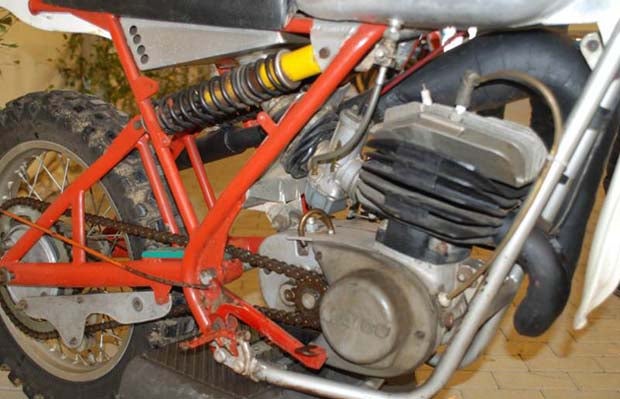
Eventually, he sauntered up to the counter. Expectantly, I awaited his order. "A pair of boots or leathers today?" I asked optimistically.
"No thanks, man," he replied. "Just give me a Twin Air filter for my mono-shock."
Enraged, I threw him out of the shop and told him to go to Bob Nevin's Yamaha down the street for his monoshock stuff. Everyone around here knows that we are into the European bikes and wage war every Sunday against the imports from Nipponland. This stranger just needed a little educating. I no sooner resumed my position, seated below the magnificent Barstow-to-Vegas Horny Owl trophy, when this character reentered the showroom protesting that he did not own a Yamaha.
My patience was at an end, and just before I was about to eject him permanently, my wife arrived with lunch. As I relented to my steaming bowl of chicken soup, this fellow began explaining that he owned a monoshock-style Maico – in fact, two of them: a 250 and a 400.
As I listened to this madness, it occurred to me that this was the sixth kook that had come in this week; I made a note to look for a better shop location. Surely this broken man must have been captured during the war and tortured until his mind snapped.
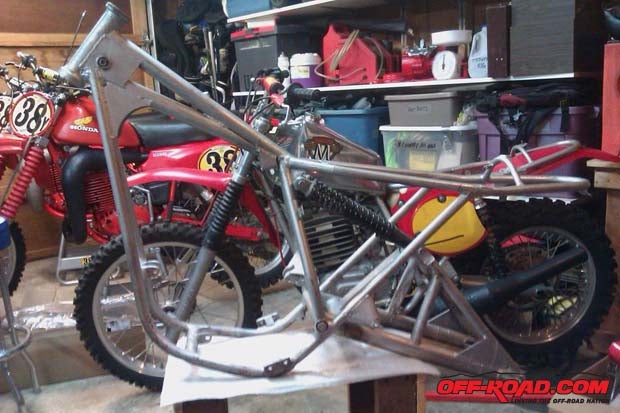
A monoshock Maico, indeed!
I slurped down the last spoonful of chicken soup and decided to comfort the poor, lost soul. Before I could calm him down, he darted out to his van and reappeared with a photograph.
I gasped audibly when he showed it to me. My irritation immediately changed to fascination. Sure enough, it was a Maico with a monoshock suspension.
However, it sported two Bilstein gas shocks, side-by-side in a monoshock configuration.
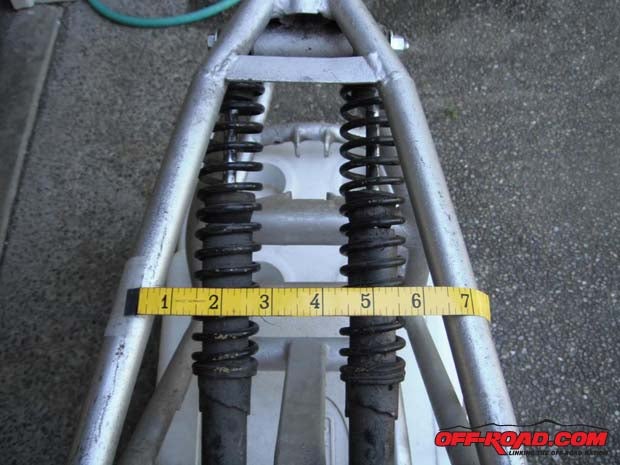
Before you could say "Kalevi Vehkonen," I bombarded him with a thousand and one questions. The chap's name was Ed Remis, and he had just been discharged from the Army in December. He had served 25 months stationed in Offenbach, West Germany, as a communication electronics technician. His home was West Seneca, New York, but he was in Chicago attending the American Motorcycle Mechanics School, intending to make a career of bikes.
He built and raced the monoshock-action Maicos in Germany, and they were shipped over to the states after his discharge.
This was too good to be true. A lousy, dismal, overcast, crummy day and in walks this Ed Remis, having just spent over two years living a few hundred kilometers from the Maico factory.
I used every bit of leverage at my disposal (two six-packs of Schlitz and the promise of 9-percent parts discount) to try and persuade Ed to journey back to New York and return with one of these rare Maicos so we could photograph, test, and add another chapter to the book of unusual suspension systems.
Ed agreed. As I walked Ed to the parking lot, I turned green with terminal envy. His Sano van sat there – a bright red with yellow lettering with the German words "Weltmeister Rennmachinen" translating to "World Master Race Machine," and the name Maico in two-foot letters above. First class!
I didn't sleep a wink for two weeks thinking that the ships transporting the bikes might have sunk, or a dock worker might have dropped the crate into the harbor, et cetera, et cetera. However, Ed arrived with a 250 Maico right on schedule. As he nervously watched, we stripped the bike down to essentials to study the layout of this unique system. The design is far less complicated than you would initially assume.
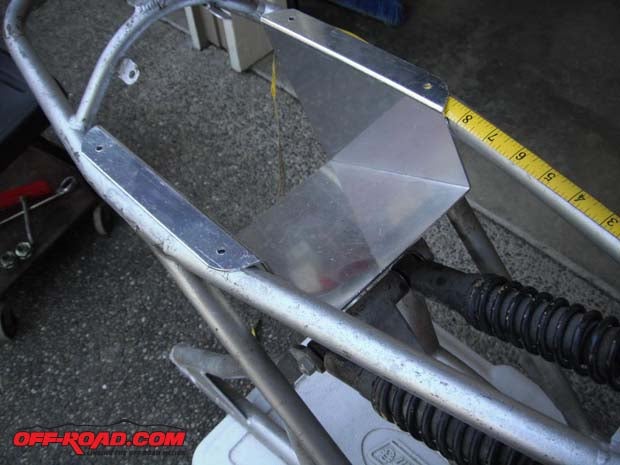
The bridgework on the swingarm is not elaborate – just short struts for the lower shock mount. A portion of the original lower shock mount on the swingarm was used as gusseting in the new configuration. The frame was in a forward mount model before Ed modified it.
The steel tubing used was the same gauge, diameter, and composition as the rest of the frame. Additional weight of the swingarm is about 1 1/2 kilograms – 3.3 pounds; however, the weight does not appreciably raise the center of gravity.
The shocks used were 11.9-inch Bilsteins and the best spring rate was an 80/125 progressive. Girling size springs were used to minimize the clearance problems.
The only complexity in the entire system was the air box. The majority of space occupied by the shock occurs where the air usually comes in. This necessitated a complex set of bends to clear the shocks and still reside under the seat, and not get in the way of the rear wheel under full compression.
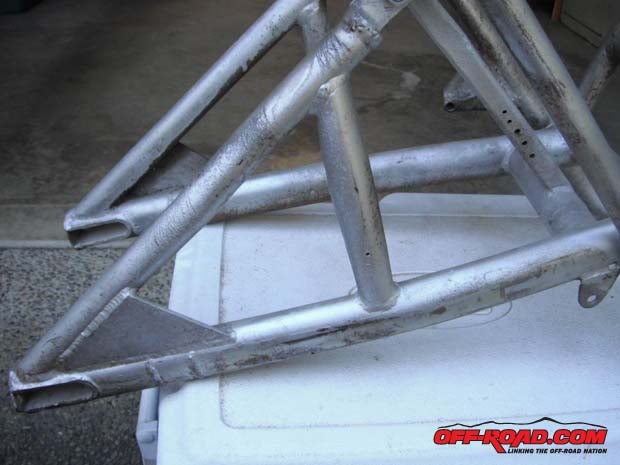
The air box was a work of art. It cleared everything and provided for an adequate-sized twin air filter made especially for the air box, which was held in place by a rubber strap. Air was transferred through the bottom of the air box in a square duct. It then passed through a rubber coupling boot, a joint at the splashplate, and then a second rubber boot to the carb inlet mouth. The splashplate keeps debris off the engine. The air boot joint at the splashplate could not have been eliminated, but it did lend rigidity to the air-induction system.
How Ed Remis obtained the design for this system is a trip in itself. This geometry for the Maico was conceived by a man well respected in Germany as a top tuner and builder, Mr. Adolph Kramer.
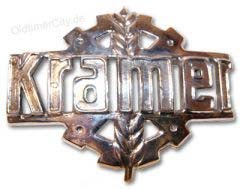
The Kramer Maico had been on the European scene for a year or more in top national competition. One afternoon, Ed took a ride down to Volgenbach, south of Frankfurt, to the home of old man Kramer to obtain the necessary components to convert his Maico to the Kramer design.
A huge German Shepherd eyed him as he approached the iron gate of the Kramer house. Hearing the dog snarl, Kramer came out of his workshop and chained the dog up to the gun turret of a partially restored Panzer tank that rested in the front yard. The dog's name was Bing – what else? They retired to his workshop, each with a bottle or two of Hiedelhiem Beer. On the back of a dirty placement advertising Kaiserslauten Aisle, Kramer roughly scrawled out technical specifications for making the conversion.
He then gave Remis a kit consisting of the Bilstein shocks, special alloy, an airbox, air boots and connectors, a special twin air filter, and the side panel number plates. Ed gave Kramer 440 marks (200 U.S. dollars), and then they proceeded to down another four beers apiece.
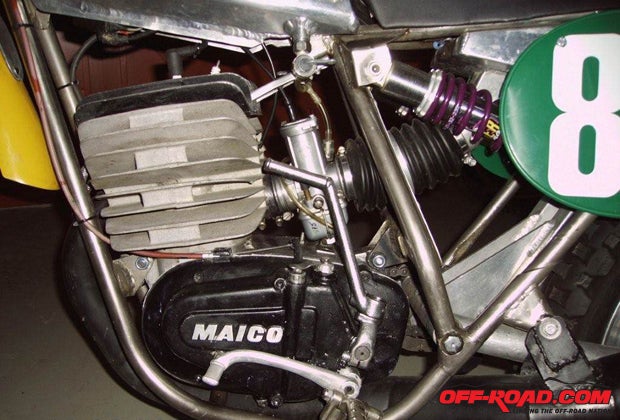
Mrs. Kramer appeared, chewed out the old man for not fixing the family VW and threatened Remis with a spot reserved for intruders in her new microwave oven.
Ed grabbed his goodies and split with a belch.
For 4,500 marks, Kramer would take a brand new machine and convert it for you that night; getting there and back was the problem.
Ed made a few improvements on the Kramer design. The original specifications called out for square mild steel tubing. Weight was saved by using Maico frame tubing and strength was also assured. The upright struts for the lower shock were also canted slightly backward to provide a more direct load to the shocks under full compression. Instead of the angle iron for the top mount, Ed opted to use round stock and put bronze bushings on the end for the shock eyes. The package is very clean looking. That splash plate was also another one of Ed's innovations.
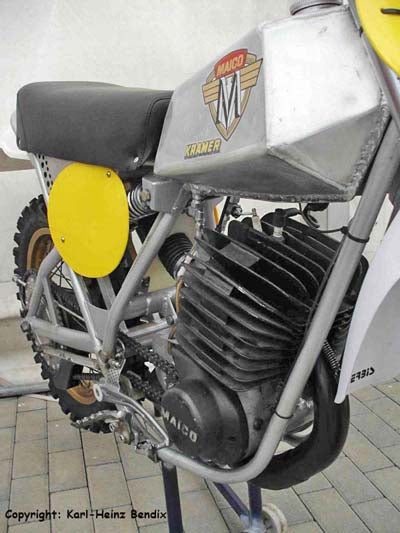
The rear wheel travel was about 6 1/2 inches – pretty close to what you get with forward-mounted shocks. Seat height was the same. The Bilsteins were mounted right side up, so dirt doesn't get a direct shot at the seals.
Riding the Kramer Maico was really neat. The Bilstein shocks have very good damping characteristics and were probably the best proven gas shocks on the market at that time. Coupling them with Progressive springs in the monoshock configuration yields a ride that is gentle in the small stutter bumps and firm over hard impact, with the smoothest transition in between. There is no tendency to buck up on bumpy downhill sections – a characteristic other mono-systems have exhibited. The center of gravity feels unchanged, yet one can still feel the additional unsprung weight of the swing arm.
Muddy conditions, here in the Midwest (monsoon season), prevented a really good workout of the machine on dry terrain. However, if you race around Illinois, or go up around West Seneca, New York, Ed will probably give you a good first-hand exhibition.


 Your Privacy Choices
Your Privacy Choices